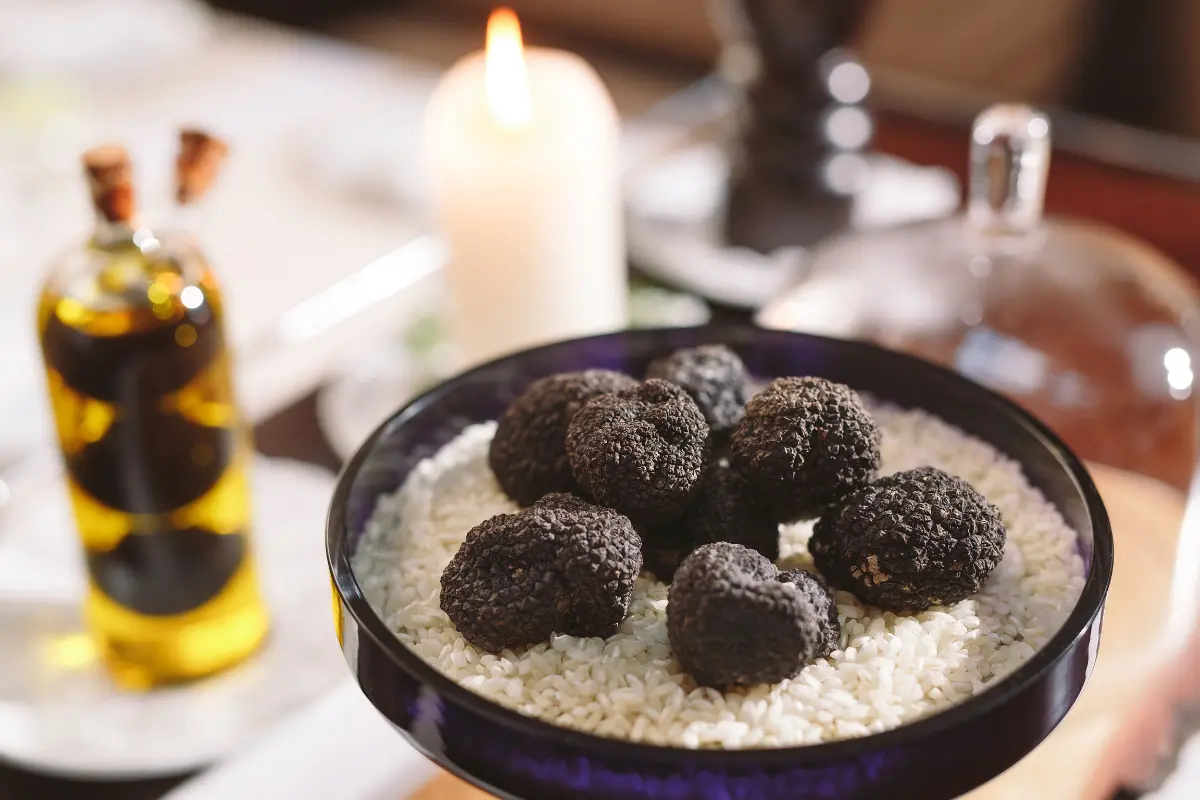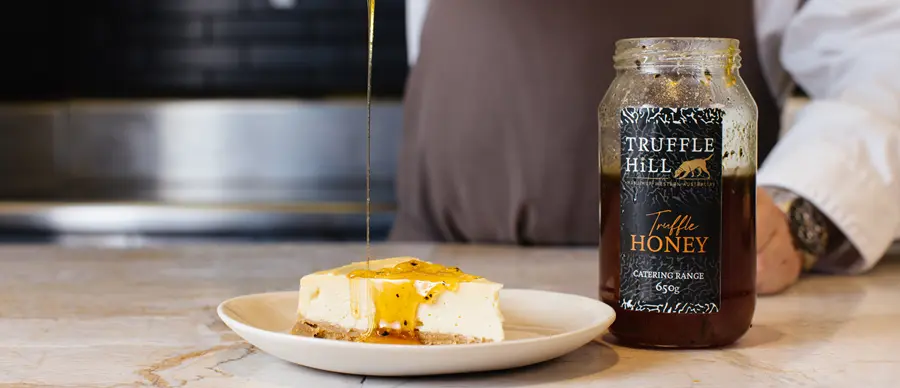
Have you ever found yourself at a fancy dinner, marvelling at a dish garnished with truffles, and wondered, “Is this exquisite addition actually a mushroom?”
With their earthy aroma and complex flavours, truffles have long occupied a place of honour in the culinary world, often surrounded by an aura of luxury and mystery. Similarly, mushrooms are celebrated for their versatility and depth, adding richness to many dishes. Yet, when it comes to distinguishing between these two fungal delicacies, even the most ardent food enthusiasts can find themselves in a bit of a pickle.
Is a truffle a mushroom, or is it an entirely different entity we’ve mistakenly lumped together with its above-ground cousins?
Stay tuned to discover how truffles and mushrooms compare, contrast, and coexist in the gastronomic galaxy.
Are Truffles Mushrooms?
The simple answer to this age-old question is yes.
Truffles are indeed a type of mushroom if we define mushrooms broadly as the fruiting bodies of fungi. However, this simple truth belies the complexity and uniqueness of truffles, which set them apart from their above-ground counterparts in several fascinating ways.
A Tale of Two Fungi
While truffles and mushrooms are both in the Fungi kingdom, their lifestyles and how they present themselves to the world couldn’t be more different.
Mushrooms, with their visible fruiting bodies, act as nature’s recyclers, breaking down dead organic matter. They come in all shapes and sizes, from the familiar button mushroom gracing supermarket shelves to the majestic fly agaric with its iconic red and white-spotted cap. They all share their role as reproductive structures, popping up above ground to release spores into the air or onto the surfaces of surrounding objects.
Truffles, on the other hand, shy away from the spotlight. These gourmet delicacies develop underground, forming symbiotic relationships with the roots of specific trees. Unlike their above-ground cousins, truffles are prized for their rarity and the intense, earthy flavours they bring to culinary creations. They’re not the fruiting bodies seen with typical mushrooms but rather the fruiting bodies of a subset of fungi that prefer the quiet and darkness of the soil.
A Fungal Family Tree
Both truffles and mushrooms are part of the phylum Ascomycota or Basidiomycota, depending on the species. Despite their differing lifestyles and appearances, this classification places them firmly within the fungal kingdom.
The key difference lies in their ecological roles and how they reproduce. While mushrooms can afford to make a grand entrance above ground, truffles have adapted to a life of secrecy, with animals such as pigs and dogs often enlisted by humans to sniff them out.
Growth Habits and Ecological Roles
Truffles thrive in specific conditions, primarily in calcareous soils within temperate forests, closely linked to the roots of certain trees like oaks and hazelnuts. This underground lifestyle is not just a quirk of nature but a sophisticated adaptation that protects their spores, relying on animals to unearth and consume them, thus facilitating spore dispersal.
In contrast, mushrooms can be found in various environments, from woodlands to your backyard. Their spores are released into the air, finding new homes wherever the conditions are right for growth. This difference in spore dispersal methods underscores the distinct ecological niches truffles and mushrooms occupy.
Physical Characteristics
On a physical level, truffles and mushrooms differ significantly. Mushrooms sport a stem and a cap, often with gills or pores underneath where spores are produced.
Truffles, devoid of these structures, are more like subterranean lumps with a dense, sometimes veiny interior. This lack of traditional mushroom features directly results from their underground development, shielded from the elements and the need for air dispersal mechanisms.
Culinary Competition: Truffle vs. Mushroom

Flavour Profiles
The most striking difference between truffles and mushrooms lies in their flavour profiles. Truffles are renowned for their intense, earthy aroma that can transform a simple dish into a luxurious experience. Their flavour is complex, with notes ranging from nutty to slightly garlicky, depending on the variety. This potent profile means that truffles are best used sparingly, often shaved over dishes as a finishing touch to impart their signature aroma.
Mushrooms, on the other hand, offer a more subtle earthiness, with flavours varying widely among the different types. The different mushroom varieties – from the mild, delicate taste of button mushrooms to the robust, meaty flavour of portobellos, mushrooms can play both supporting and starring roles in a dish. They’re versatile and able to absorb and complement the flavours of other ingredients, making them a staple in cuisines worldwide.
Texture and Culinary Uses
The texture is crucial in how truffles and mushrooms are used in cooking. With their firm yet slightly spongy texture, truffles are rarely cooked or often added towards the end of the cooking process. They’re shaved or grated over dishes, adding a burst of flavour to pasta, risotto, and even desserts.
Mushrooms, with their varied textures, from the silky smoothness of shiitakes to the hearty chew of portobellos, can be sautéed, grilled, roasted, or used as a base for soups and sauces. Their ability to take on different textures depending on the cooking method adds to their culinary versatility.
The Impact of Truffle’s Luxury Status
Traditionally, black or white truffles are reserved for special occasions or high-end dishes due to their luxury status and high price. However, the allure of truffles has paved the way for creating truffle-infused products, making the exquisite taste of truffles more accessible for everyday enjoyment. This development has democratised truffle flavours, adding a layer of intrigue and desire to everyday dishes.
Mushrooms, while also prized in their own right, are more accessible and widely used. This accessibility means that mushrooms can be enjoyed in everyday meals, from breakfast omelettes to hearty dinner stews, making them a beloved ingredient across socio-economic spectrums.
Conclusion
As we investigate the fascinating world of truffles and mushrooms, we’ve uncovered the layers of mystery that surround these culinary gems. From their ecological roles to their unparalleled flavours and textures, it’s clear that both truffles and mushrooms hold revered places in the culinary world. While truffles may capture the imagination with their elusive nature and intoxicating aroma, mushrooms offer a versatile canvas that complements many dishes across global cuisines.
For those eager to explore further the luxurious world of truffles, why not explore the offerings of Truffle Hill? Visit our website to discover our exceptional fresh truffles, or browse a curated selection of truffle-infused delights and mouth-watering truffle recipes. From the earthy sophistication of our truffles to a wide array of gourmet products, Truffle Hill invites you to bring the magic of truffles into your culinary adventures.



